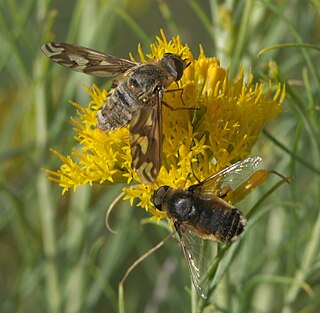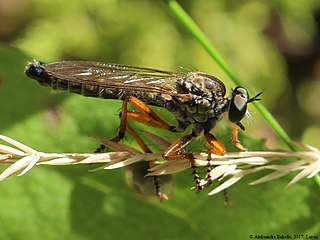
Poecilanthrax willistoni, Williston's bee fly or sand dune bee fly, is a member of the Bombyliidae insect family. This family includes the bee flies, true flies that have developed Batesian mimicry characteristics to avoid predators. That is, they look like bees because that helps them avoid bee-wary predators, but they lack stingers.

Arctops is an extinct genus of gorgonopsian therapsids known from the Late Permian of South Africa. It measured up to 2 metres in length and its skull was 30 centimetres (12 in) long. The type species is Arctops willistoni. A second species, A. watsoni, may be synonymous with A. willistoni. A. kitchingi may be a third species of Arctops, but it was only tentatively assigned to the genus when it was first named. Both were formally synonymized with A. willistoni by Christian Kammerer in 2017.
Euxesta willistoni is a species of ulidiid or picture-winged fly in the genus Euxesta of the family Ulidiidae. It was described by Daniel William Coquillett in 1900.

Drosophila willistoni is a species of fruit fly. It was originally described by Alfred Sturtevant in 1916. It ranges from Florida, Mexico and Caribbean islands southwards to Argentina and is the most common Drosophilid fruit fly in the Amazon rainforest.

Neolasioptera is a genus of gall midges in the family Cecidomyiidae. There are at least 130 described species in the genus Neolasioptera.

Neomochtherus pallipes, the Devon red-legged robber fly, is a species of robber fly in the family Asilidae.

Neomochtherus is a genus of robber flies in the family Asilidae. There are at least 140 described species in Neomochtherus.
Neomochtherus comosus is a species of robber flies in the family Asilidae.
Cyrtopogon willistoni is a species of robber flies in the family Asilidae.

Neolasioptera willistoni is a species of gall midge in the family Cecidomyiidae.
Neomochtherus auricomus is a species of robber flies in the family Asilidae.
Proctacanthella willistoni is a species of robber flies in the family Asilidae.
Megaphorus willistoni is a species of robber flies in the family Asilidae.

Cerotainia is a genus of robber flies in the family Asilidae. There are at least 30 described species in Cerotainia.
Neomochtherus latipennis is a species of robber flies in the family Asilidae.
Neomochtherus californicus is a species of robber flies in the family Asilidae.
Thrypticus willistoni is a species of long-legged fly in the family Dolichopodidae.

Neomochtherus geniculatus is a species of fly in the robber fly family, Asilidae.









